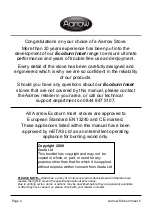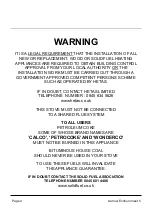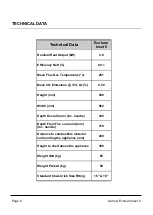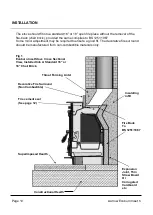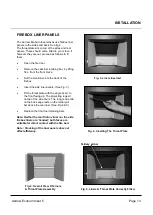
INSTALLATION
Page 12
Aarrow Ecoburn Inset 5
FOR ALL APPLIANCES
Access for cleaning the flue should be
incorporated in the system other than through the
appliance (eg: a soot door or access through
register plate). Purpose made soot doors and
inspection lengths are available from manufactures
of all systems. Ensure that the whole length of the
flue can be reached from the soot door.
Note: If the appliance is fitted with a draught
stabiliser or if one is fitted to the flue pipe or
chimney in the same room as the appliance,
then the permanent air entry opening (or
Openings) should be increased by 300mm2
for each KW of rated output.
For advice on flues and chimneys contact:
NACE (National Association of Chimney
Engineers)
Telephone : 0800 0924019
www.nace.org.uk
OR
NACS (National Association of Chimney
Sweeps)
Telephone : 01785 811732
www.chimneyworks.co.uk
OR
HETAS (Official Body To Approve Solidfuel
Domestic Heating Appliances)
Telephone : 0845 6345626
www.hetas.co.uk
IMPORTANT NOTICE:
During installation it is advisable to remove the
Stove Door
. The stove may become
front heavy
should the door be opened during positioning, prior
to the stove being secured in place with the
provided masonry bolts, ( See page 14 ). If the
stove is left unsupported and the door is fully open
it may tip forward causing damage to the stove
door or stove body or to the surrounding hearth /
brickwork etc.
Sealing the back and base of the
stove to the decorative fire surround
and hearth
In order for the stove to operate correctly and at
maximum efficiency it is necessary to achieve a good
seal between the back face of the stove convector
section, the stove base section and the decorative fire
surround and hearth (See Fig 1 on page 10)
This should be achieved using fire cement.
Remember
fire cement is caustic and hand and eye protection
should be worn.
Carefully press fire cement all around the base under
the stove where the metal meets the heath surface and
around the stove where the body meets the decorative
fire surround. Use sufficient fire cement to ensure a
good seal.
Check there is a good seal when the fire is first lit.
See fig a. and fig b. below.
Fig a.
Sealing the base of
the stove and the
hearth
Fig b.
Sealing the back of the
stove to the fireplace
surround


